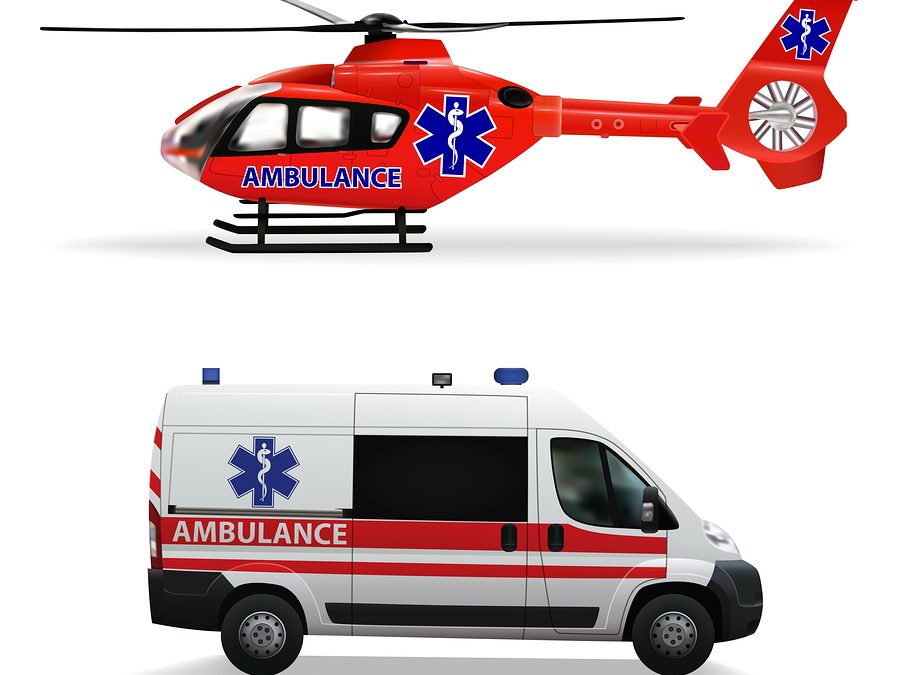Medical bills that arise from an emergency situation may result in much higher charges than charges for non-emergency care. In an emergency, you do not have time to call your insurance company to ask about what they will cover. As a result, you may find yourself with higher medical bills from an ambulance or air ambulance transport. For example:
Your emergency room physicians are out-of-network when you arrive at an in-network facility:
• The ambulance sent in response to your 911 call is out-of-network
• The closest emergency facility to your emergency is out-of-network
According to Fitch and Associates President Jay Fitch, most ambulance rides were free for patients 40 years ago. Ambulance services were provided by volunteers or the local fire department using taxpayer money. Today, ambulances are primarily run by private companies and venture capital firms.
Ambulances that are staffed by paramedics instead of Emergency Medical Technicians (EMTs) will result in a higher charge – even if the patient does not require the higher level of care.
The ambulance bill you receive is based on a few factors:
• A base cost for the ambulance’s time
• Cost of services you received onboard the ambulance (e.g., oxygen, IV hydration, emergency medication)
• The location of your medical emergency
No matter which ambulance you use, one thing is certain: The bill will not be cheap.
Do you really need an ambulance?
The Thousand Islands Emergency Rescue Service recommends using the following checklist to evaluate whether you should call an ambulance:
• Are you or someone else in immediate danger of losing your life?
• Could your condition worsen on your way to the hospital?
• Could movement lead to additional complications or injuries?
• Do you need skilled medical treatment immediately?
• Would an ambulance ride be faster than any other means of getting to the hospital?
According to the U.S. Government Accountability Office (GAO), the cost of ground ambulance transports varies widely – from $224 to $2,204 per transport. Ambulance services and private insurance companies often do not agree on a fair price. So the ambulance service refuses to join the insurance network. Patients are stuck in the middle, with nonnegotiable, often-exorbitant out-of-network charges.
The GAO also found that from 2010-2014, charges for helicopter air ambulance service doubled, from $15,000 to $30,000 per transport. Ira Blumen, from the University of Chicago Department of Medicine, found that in the past 15 years, the U.S. air ambulance fleet has doubled in size to nearly 900 helicopters; the issue is clearly not supply.
At the heart of the issue for consumers is a gap between what insurance will pay for a flight and what air ambulance companies say they must charge to keep flying. Air ambulance companies claim that reimbursements from U.S. government health programs, including Medicare and Medicaid, do not cover their expenses. When the health plans fail to pay, ambulance companies ask others to pay more – and patients get stuck with the bill.
The air ambulance industry continues to escape regulatory management of their excess billing under the 1978 Airline Deregulation Act. Under the Act, air ambulance operators are considered air carriers – similar to Delta Air Lines or American Airlines – and states have no power to curb the rates they charge customers for service.
How do you handle an ambulance or air ambulance bill?
Despite the law keeping ambulance costs from being regulated, there are still a few things you can do to reduce the expense of your emergency ride.
• Check your bill to ensure that the correct insurance codes were used.
o Emergency codes are required in order for your insurance to pay an ambulance fee.
o Call the ambulance billing department and request them to change the non-emergency codes to emergency codes so that your insurance will cover the bill.
• Request an itemized bill and check for medical billing errors.
• Ask your insurance company to pay more.
o Call your insurance company when you receive the “balance billed” to find out if there is any additional payment due. Your insurance company has paid their share and you are left with the “balance owed.”
o Explain to your insurance company the reason the ambulance was needed.
o Provide specific details of the emergency situation.
• Call the ambulance’s billing department.
o Negotiate a lower amount. They want to get paid.
o Ask if there is a financial assistance program.
o Ask if they offer you a “pay now” discount or a monthly payment plan.
• For exploitative fees, file complaints with your state insurance commissioner’s office, state attorney general’s office, and the Better Business Bureau.
How do you prepare for an emergency?
The best way to mitigate the costs of an ambulance ride is to be proactive and prepare for an emergency situation.
• Figure out ahead of time if you would need an ambulance or an air ambulance based on where you live.
• Visit your local fire department and ask which ambulance service responds to 911 calls from your home address and for your town. Ask who owns the ambulance service to determine if it is run by the government or a privately owned contractor.
• Ask what the standard charges are for an ambulance transport to the local hospital.
• If a private company services your area, ask them about their policies on “balance billing.” (Balance billing is when a healthcare provider bills you for the difference between the provider’s charge and the allowed amount.)


Recent Comments